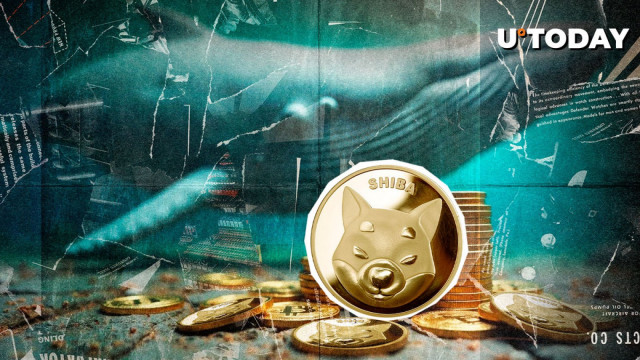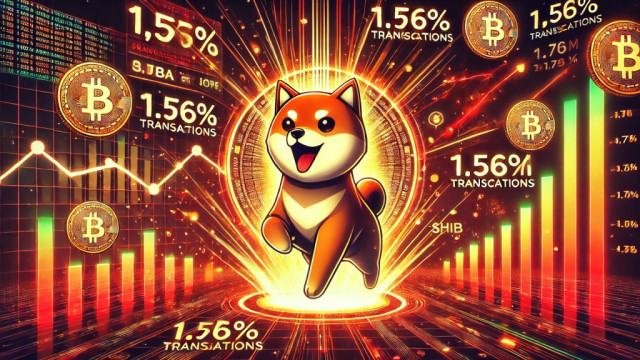
Language
- English
- Română
Currency
- $ USD
- € EUR
Shiba Inu burn rate volatility raises questions about SHIB's future price

More News Articles
Shiba Inu, Dogecoin Now Held as Long as Ether As Memecoin Holders' Confidence Surges
As investors grapple with the cryptocurrency market's next moves amid recent turbulence driven by geopolitical and economic concerns, attention is shifting away from established top-cap coins like Bitcoin (BTC), Ethereum (ETH), Solana (SOL), and Cardano (ADA) toward the burgeoning appeal of meme coins.
Here's Why The ‘Very Negative Crowd Sentiment' for XRP and SHIB Could Be Bullish
Check out why XRP, SHIB, and other leading cryptocurrencies could head north soon.
Shiba Inu Team Introduces New SHIB Burning Method Via Shibarium
The WoofSwap team, operating the decentralized exchange (DEX) on the Shibarium network, has unveiled a novel Shiba Inu token-burning mechanism through the introduction of a new token named FEED. TThe announcement was made via X, where WoofSwap detailed the intended impact of FEED.
PEPE Edges SHIB in Socials: SHIB Bulls Still Eyeing $0.000022?
Fiery competition between the blue-chip meme coins sends the meme section up 21%, defying broader market momentum.
Shiba Inu (SHIB) Rockets 540% in 24 Hours in Bullish Whale Activity
The popular meme-inspired Shiba Inu (SHIB) cryptocurrency continues to make headlines, this time with a staggering more than fivefold increase in a key on-chain metric.
Bitcoin, Dogecoin, And Shiba Inu Have The Longest HODL Period: IntoTheBlock
According to the market intelligence platform IntoTheBlock, Bitcoin (BTC), Dogecoin (DOGE), Shiba Inu (SHIB), and Ethereum (ETH) have emerged as the coins with the longest holding period. This is significant because it indicates that crypto investors have the most faith in these coins.
Dogecoin (DOGE) and Shiba Inu (SHIB) Hit Tie in This Metric
Per IntoTheBlock data, Dogecoin and Shiba Inu are among the longest HODLed coins in the market.
Shiba Inu Next in Line for Whale-Induced Rally, Here's Why
Shiba Inu (SHIB) has many battles to fight to keep up its promising outlook. Shiba Inu whales have stepped up in the ongoing fight against sell-offs from some HODLers.
Only 2%: This Shiba Inu (SHIB) Inu Metric Is Raising Questions
Concern is being raised by Shiba Inu after a crucial on-chain metric provides an unexpected glimpse into the condition of its holders. Data shows that only 2% of SHIB holders are classified as short-term investors, which indicates that very little of SHIB's supply is being purchased and sold quickly.
Mysterious Shiba Inu (SHIB) Whale Stuns Major US Exchange With $2.2 Million Withdrawal
According to data from Arkham Intelligence, an unknown whale took practically 12.7 billion Shiba Inu (SHIB) tokens from the largest crypto exchange in the United States, Coinbase, late yesterday. This amount of the popular meme-inspired cryptocurrency is equivalent to just over one-fifth of a million dollars and represents nothing out of the ordinary.
Zero SHIB Burn Rate in 24 Hours: What It Means for Shiba Inu Price?
The second biggest meme coin, Shiba Inu, has been depending on the SHIB burn mechanism in hopes of increasing its scarcity and providing more stability in the price. Even since the introduction of token burning, Trillion of tokens have been reduced from the total supply, but there is no significant difference in the SHIB price
Shiba Inu Loses Ground And Continues Its Range-Bound Trend
The price of Shiba Inu (SHIB) has fallen further above the moving average lines. The bulls and bears are trying to hold above the 21-day moving average as the cryptocurrency continues to lose ground.
Shiba Inu Faces Pressure: How Derivative Traders Could Amplify SHIB Losses
The cryptocurrency market is currently grappling with bearish trends, and Shiba Inu (SHIB) is no exception. Recently, SHIB saw a 3% drop in value over 24 hours, trading at $0.0000185.
Will Shiba Inu coin reach $1?
The value of Shiba Inu, the second-largest meme coin behind Dogecoin, has been fluctuating a lot recently, much like many other coins in the crypto market.
Zero SHIB Burned in 24 Hours – What's Going On?
According to the Shibburn meme wallet tracker, over the past 24 hours, the SHIB community has not advanced in burning their favorite meme coin. The data source shows zero Shiba Inu coins scorched with a minus 100% reading of this metric.
Shiba Inu Burn Rate Soars 6,750% as SHIB Price Struggles Amid Market Uncertainty
Shiba Inus burn rate skyrocketed by 6,750% within a single day, eliminating 27.1 million SHIB tokens, despite a 7.31% decline in price this week. The surge in burns comes alongside heightened transaction activity, indicating strong community support for the tokens supply reduction.
Shiba Inu Shatters All-Time High With 1,557% Surge in Shibarium Activity, 1.76M Daily Transactions
Shiba Inus Shibarium blockchain hit an unprecedented all-time high, with activity spiking by 1,557% in just 24 hours. This surge pushed daily transactions to an astonishing 1.76 million, marking a significant milestone for the network.
Bitcoin, Shiba Inu, and Chainlink Dominate Santiment's Hotlist as $230K BTC Target Looms
Santiments latest analysis ranks Bitcoin, Shiba Inu, and Chainlink among the top cryptos with soaring market sentiment. As analysts predict Bitcoin could hit $230K, these coins are set to be major players in the next rally.
SHIB burns +300M tokens: What does it mean for Shiba Inu investors?
The recent SHIB burns have surged significantly, with over 300 million tokens burned in just a week. Despite this, price has continued its downtrend.
Shiba Inu (SHIB) Very Close to Failure, XRP Returns to July Level: What to Expect, Bitcoin (BTC) Has to Avoid Falling Below This Level
Shiba Inu is currently hovering close to a crucial trendline support level putting, it on the verge of a major breakdown. Any decline below this trendline could be problematic for the price of SHIB, as it has been crucial to sustaining the asset's growth trajectory.
Analyst Predicts Shiba Inu Price Could Surge 330% Following Hidden Bull Divergence.
Shiba Inu (SHIB) price, a meme-based cryptocurrency, is experiencing a market correction. In recent days, a notable decrease in the SHIB's value has been observed, indicating a bearish trend.
Price analysis 10/23: BTC, ETH, BNB, SOL, XRP, DOGE, TON, ADA, AVAX, SHIB
Bitcoin's correction ignited selling in altcoins, which are slipping below critical support levels.
Trader Shares 3-Point Strategy To Win With Meme Coins—Here's Where Dogecoin, Shiba Inu Come In
Pseudonymous crypto trader Hoeem outlined a three-wave trading strategy to navigate the volatile meme coin markets. What Happened: Hoeem took to X to outline his approach that categorizes trading into three distinct waves.
Shiba Inu's Shibarium Suddenly Breaks All-Time High With 1,557% Spike in Activity
Shiba Inu (SHIB) is in the news again, this time with a huge spike worth 1,557% observed on Shibarium. According to data from Shibariumscan, the layer-2 blockchain designed by and for the popular meme-inspired cryptocurrency, saw a spike worth that much in the last 24 hours.
AI Meme Coin GOAT Keeps Showing Dogecoin, Shiba Inu How It's Done, Hits All-Time High After 56% Gain And Exchange Listing
Goatseus Maximus (CRYPTO: GOAT), an AI-created meme coin, has been gaining significant momentum, with a 160% week-over-week gain and a listing on centralized exchange ByBit. What Happened: ByBit on Wednesday stated that it had listed a GOAT perpetual contract for trading with up to 12.5x leverage.
'Dogecoin Killer' Shiba Inu Burn Rate Soars 6,750%: Watch This Indicator Potentially Kicking Off A 355% Rally, Says Trader
Shiba Inu (CRYPTO: SHIB) is gaining attention from traders after a dramatic rise in its burn rate and daily transactions. What Happened: According to Shibburn data, Shiba Inu's burn rate skyrocketed by 6,750.7%, led by a 27.1 million coin burn 15 hours ago.
Shiba Inu (SHIB) Shows Strong Network Activity: Massive Burns, Whale Movements, and Shibarium Growth
Shiba Inu network activity shows significant growth across multiple metrics, with a 6,750% increase in token burns, 240% surge in whale transactions, and 1,300% growth in Shibarium daily transactions.
Shiba Inu (SHIB) set for recovery as Shibarium activity surges after months-long stall
Dog-themed crypto Shiba Inu (SHIB) has underperformed lately as investors focused on new and trending meme tokens such as POPCAT and PEPE. While the 5% price dip over the past week highlights weakness, recent trends suggest a potential comeback for SHIB.
SHIB Burns Skyrocket 6,750% - Here's What's Happening
Data provided by the public Shibburn tracker shows that there has been substantial progress in removing SHIB meme coins from the circulating supply over the last day.
Shiba Inu, Dogecoin, Bonk and Others: Classic Meme Coins Get Massive Advantage
Traditional memecoins like Shiba Inu, Dogecoin and Bonk have a major edge according to recent listing trends on Upbit, the biggest exchange in South Korea. DeSpread claims that the South Korean exchange has been cautious when it comes to listing memecoins taking into account only those that have been traded for a minimum of two years.
Key Shibarium Metric Skyrockets by 1,300%: Is Shiba Inu (SHIB) Preparing for Price Rally?
Here's what signals that SHIB might be gearing up for a rally in the short term.
Shiba Inu Burn Rate Surges 6750%, SHIB Community Vouch for $0.01 Price Target
The renowned dog-themed meme crypto SHIB has once again fueled optimism among crypto market traders globally, recording a remarkable surge in the Shiba Inu burn rate on Wednesday. Latest burn data suggests that nearly 27 million coins were taken out of the supply, igniting market optimism surrounding the meme coin's future movements.
Cat Victory Over Dogs? Popcat Rally Defies Dogecoin, Shiba Inu Decline, Coin's YTD Gains Skyrocket 15344%
Cat-themed Popcat (POPCAT) shrugged off declines in the meme coin space to emerge as one of the market's biggest gainers on Tuesday. What happened: The Solana (CRYPTO: SOL)–based coin rose 5.63% in the last 24 hours, becoming the second-best-performing cryptocurrency in the market.
Shiba Inu's Shibarium Shocks With 3,370% Transaction Surge—What's Fueling This Massive Spike?
Shiba Inus Shibarium saw an astonishing 3,370% jump in transactions within days, skyrocketing from 3,690 to over 324,000. The surge hints at growing community adoption, though the exact trigger remains unclear.
Shiba Inu Whales Withdraw 1.2 Trillion SHIB—What's Holding Back the Price?
In the wake of a minor price dip, whales have withdrawn 1.2 trillion Shiba Inu tokens valued at $21.7 million from centralized exchanges. Despite this massive accumulation, SHIBs price remains subduedraising questions about whats next.
Dogecoin And Shiba Inu Go Head-To-Head For Price Dominance – A New King Emerges For $9,230% In The Next 30 Days
As the Dogecoin price and Shiba Inu price compete for supremacy, a new contender, ETFSwap (ETFS), is capturing attention with an astonishing forecast of a $9,230% increase over the next 30 days, positioning itself as a potential game-changer in the crypto market. Dogecoin Gs.
Ethereum (ETH) $3,000 Comeback Is Over, Dogecoin (DOGE) 7.7 Billion Price Peaks, Will Shiba Inu (SHIB) 40% Price Growth Continue?
Hopes of a rally toward $3,000 were raised by Ethereum's recent 15% price increase but it looks like the upward momentum has encountered a major obstacle. For ETH the 100 EMA has shown to be a strong resistance level and the assets recovery appears to have stalled at this point.
Shiba Inu: How derivative traders could fuel SHIB losses
Traders might be closing their existing positions to minimize losses from liquidations.
Is SHIB Preparing to Say Goodbye?
Shiba Inu's unusual support for its competitors sparks thoughts: what if its time is running out?
SHIB Price Prediction for October 22
Some coins keep setting new local peaks, while others have come back to the red zone by now, according to CoinStats.
Shiba Inu Price Could Resume Uptrend To $0.00002 As Whale Transactions Jump 240% To 3.42 Trillion SHIB
Shiba Inu whale transactions have skyrocketed by a whopping 240%, as large-scale investors have been seen moving trillions of SHIB tokens this week. Considering the significant increase in SHIB whale movements, the price of Shiba Inu could continue its previously halted uptrend to $0.00002.
1 Trillion Shiba Inu in 24 Hours: Why Is SHIB Price Still Down?
An amazing development has occurred for Shiba Inu (SHIB) amid the recent price dip. The broader crypto market witnessed a price correction, with Bitcoin (BTC) slightly dropping below its crucial levels.
What are the Chances of Shiba Inu Price Hitting $1?
Shiba Inu price has seen a significant increase since its inception, and investors are speculating about the probability of the meme coin surging to $1. SHIB already has a massive market cap of $10 billion, and at an all-time high, it hit around $60 billion.
SHIB Holders Brace as 142 Trillion Tokens Face Key Support Test
SHIB has fallen by 3.5% today, with the meme token's fall to $0.00001803 coming as the cryptocurrency market also sheds 3.5% in 24 hours.
Shiba Inu news: Analysts predict 71% potential rally for SHIB
Shiba Inu might net an extra +70% recovery gains if its reclaims $0.00003260. But short-term uncertainty remains.
Shiba Inu Soars: Analyst Predicts 71% Rally In ‘Meme Super Cycle' – Details
Rising as one of the best-performing meme coins, Shiba Inu (SHIB) keeps making headlines in the crypto scene. The meme coin has jumped by over 30% during the past month, drawing both retail and analytical interest.
Possible Shiba Inu (SHIB) Golden Cross in 100 Days: Now or in 2025?
Within the next 100 days, Shiba Inu may be about to form a golden cross, which is traditionally regarded as a bullish signal on conventional financial markets. The onset of a notable uptrend is frequently linked to this technical formation, which happens when a shorter-term moving average (such as the 50-day EMA) crosses above a longer-term moving average (such as the 200-day EMA).




































































